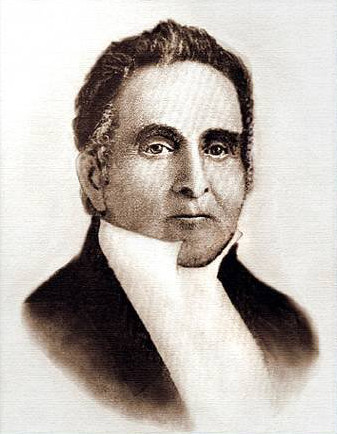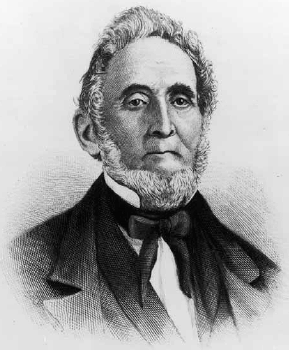Sidney Rigdon
(1793-1876)




By Susan Easton Black
In the fall of 1830 Parley P. Pratt introduced Sidney to the Restoration. Having been a Baptist preacher and a founder of the Campbellite movement, Sidney was skeptical about the restoration message that Parley shared. Reading the Book of Mormon convinced him that Parley was telling the truth. Sidney entered baptismal waters on November 14, 1830.
From the time of his baptism, Sidney held important positions in the Church. He was asked to dedicate Independence, Missouri as the land of Zion, pronouncing “this land consecrated and dedicated to the Lord for a possession and inheritance for the Saints.”1 He scribed much of the translation of the Old and New Testament as dictated by the Prophet Joseph Smith. He was named or shared in many revelations received by the Prophet, including the visions of glory (D&C 76). He became a spokesman for Joseph Smith and a strong defender of the faith.
Because of his religious convictions, Sidney faced unbridled persecution. On the evening of March 24, 1832 in Hiram, Ohio, Joseph “saw Elder Rigdon stretched out on the ground” after an unruly mob had had their way with him. “I supposed he was dead,” Joseph wrote.2 Two days later as Joseph visited with Sidney, he found him delirious—a direct result of the physical abuse of the mob. For years Sidney suffered from delusions and disturbing rantings and ramblings which probably stemmed from the night a mob reigned in Hiram.
On March 18, 1833 Sidney was called to serve in the First Presidency of the Church. “Brother Sidney is a man whom I love,” wrote the Prophet Joseph, “but he is not capable of that pure and steadfast love for those who are his benefactors that should characterize a President of the Church of Christ . . . But notwithstanding these things, he is a very great and good man . . . He is a man whom God will uphold, if he will continue faithful to his calling.”3
Sidney’s love of the Prophet Joseph and The Church of Jesus Christ of Latter-day Saints was tested in Missouri. He was taken prisoner and incarcerated in Independence, Richmond, and Liberty. The ill-treatment he received in jail led Sidney to claim “the sufferings of Jesus Christ were a fool to his.”4 At a court proceeding addressing the charges that had cast Sidney and other Latter-day Saints leaders in prison, Sidney spoke in his behalf. Famed attorney Alexander Doniphan recorded, “Such a burst of eloquence it was never my fortune to listen to, at its close there was not a dry eye in the room, all were moved to tears.” One man in the courtroom said, “We came here determined to do injury to this man. He is innocent of crime. . . . And now, gentlemen, out with your money and help the man to return to his destitute family.”5 Funds were raised and given to Sidney.
From the time Sidney was allowed to leave Liberty Jail while other Latter-day Saint prisoners remained incarcerated, he had only a minor role in the Church even though he held the position of a counselor in the First Presidency. On March 27, 1843 the Prophet Joseph wrote to him, “I believe and am laboring under the fullest convictions that you are actually practicing deception and wickedness against me and the Church of Jesus Christ of Latter-day Saints.” Joseph concluded his letter by penning, “I must, as a conscientious man publish withdrawal of my fellowship from you to the Church.”6
Sidney was cut off from the Church on August 13, 1843 but soon reinstated. At the October 1843 Church conference, Joseph attempted to remove Sidney as his counselor. Church members voted that Sidney be retained in his position. “I have thrown him off my shoulders, and you have again put him on me,” Joseph said. “You may carry him, but I will not.”7
After the conference, Sidney soon moved to Pittsburg, Pennsylvania. Just before his martyrdom in June 1844, Joseph said, “Poor Rigdon, I am glad he is gone to Pittsburg out of the way, were he to preside he would lead the Church to destruction in less than five years.”8 After the death of Joseph, Sidney offered to be “guardian” of the Church and to take Church members to Pittsburg. In September 1844 fellowship was withdrawn from him.
Sidney resided in Pittsburg the remainder of his life. He organized the Church of Christ on April 6, 1845. His church failed to prosper. Sidney died in July 1876 at age 83.
1. John Whitmer, An Early Latter Day Saint History: The Book of John Whitmer F. Mark McKiernan and Roger D. Launius, eds. (Independence, MO: Herald Publishing House, 1980), p. 79.
2. Lucy Mack Smith, History, 1845, p. 216. Joseph Smith Papers.
3. History, 1838-1856, volume A-1 [23 December 1805-30 August 1834], p. 380. Joseph Smith Papers.
4. John Jaques, “The Life and Labors of Sidney Rigdon,” Improvement Era 3 (February 1900): 265-266.
5. Saints’ Herald, August 2, 1884, as cited in F Mark McKiernan, “Sidney Rigdon’s Missouri Speeches,” BYU Studies (Autumn 1970), p. 91.
6. Letter of Joseph Smith to Sidney Rigdon, March 27, 1843. Joseph Smith Papers.
7. History, 1838-1856, volume E-1[1 July 1843-30 April 1844]. Joseph Smith Papers.
8. History, 1838-1856, volume F-1[1 May 1844-8 August 1844]. Joseph Smith Papers.
